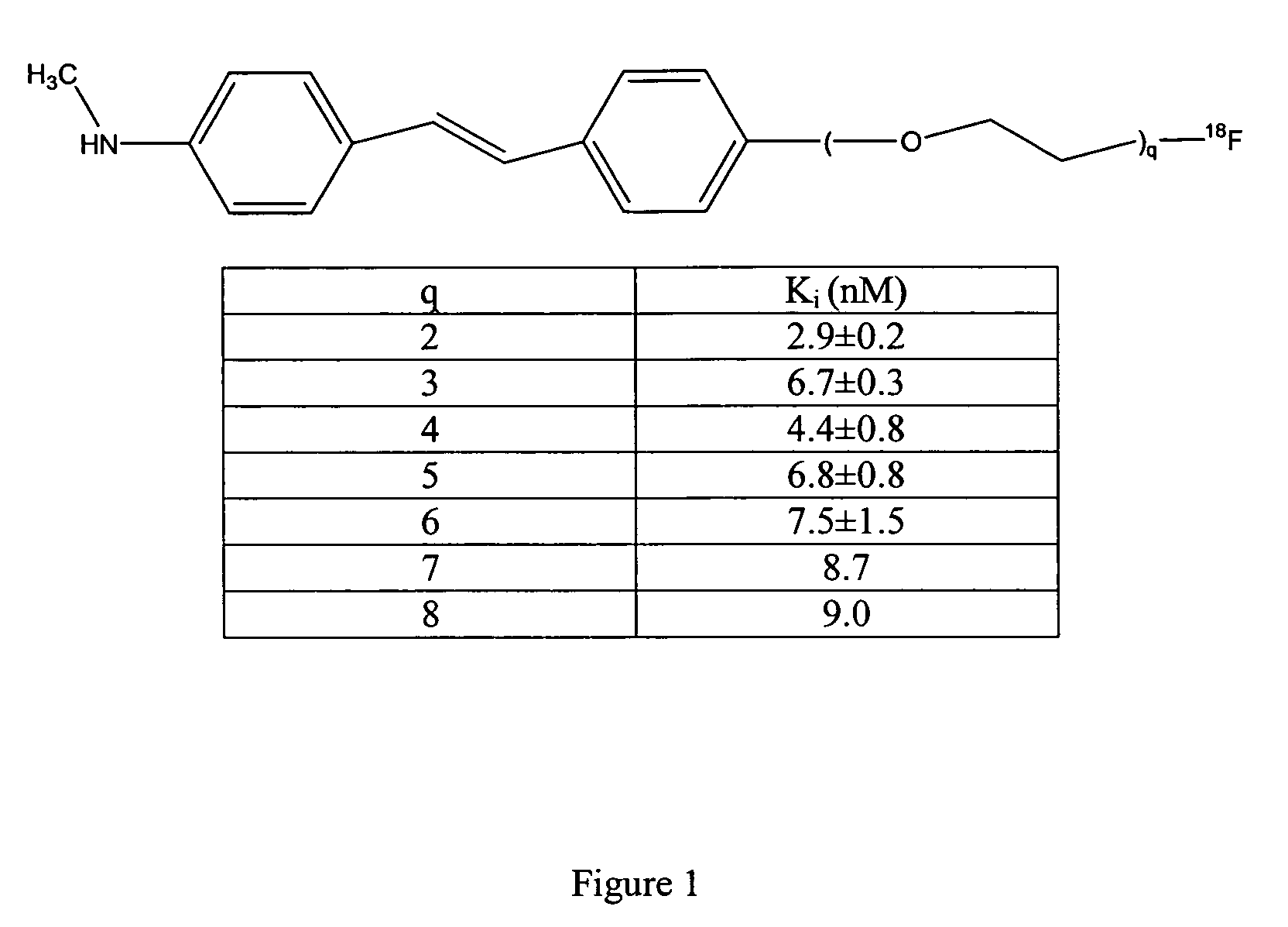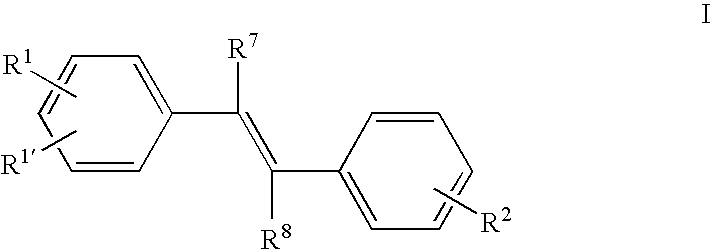Stilbene derivatives and their use for binding and imaging amyloid plaques
a technology of amyloid plaques and derivatives, which is applied in the field of bioactive compounds, can solve the problems of amyloid deposits being difficult to direct imaging in vivo, and amyloid deposits being difficult to imag
- Summary
- Abstract
- Description
- Claims
- Application Information
AI Technical Summary
Benefits of technology
Problems solved by technology
Method used
Image
Examples
example 1
2-(2-{4-[2-(4-Methylamino-phenyl)-vinyl]-phenoxy}-ethoxy)-ethanol (3a)
[0151]Under the nitrogen atmosphere, 4-methylamino-4′-hydroxy stilbene, 1 (Ono M, et al., Nucl Med Biol. 2003; Wilson A, et al., J Labelled Cpd Radiopharm. 2003) (63 mg, 0.28 mmol) and 2a (42 mg, 0.34 mmol) were dissolved in anhydrous DMF (5.0 ml) followed by an addition of potassium carbonate (125 mg, 0.91 mmol). The suspension was heated to 100° C. and stirred overnight. After cooled down to room temperature, standard workup with dichloromethane was applied and the residue was purified by silica gel preparative TLC (4% methanol in dichloromethane) to afford compound 3a (67 mg, 76%): 1H NMR δ 7.37 (m, 4H), 6.89 (m, 4H), 6.63 (d, 2H, J=8.48 Hz), 4.16 (t, 2H), 3.88 (t, 2H), 3.78 (t, 2H), 3.68 (t, 2H), 2.87 (s, 3H), 2.20 (br, 1H), 1.55 (br, 1H).
example 2
2-[-2-(2-{4-[2-(4-Methylamino-phenyl)-vinyl]-phenoxy}-ethoxy)-ethoxy]-ethanol (3b)
[0152]Compound 3b was prepared from 1 (150 mg, 0.67 mmol), 2b (136 mg, 0.81 mmol), and potassium carbonate (277 mg, 2.01 mmol) in DMF (10 ml) with the same procedure described for compound 3a. 3b (180 mg, 76%): 1H NMR δ 7.37 (m, 4H), 6.89 (m, 4H), 6.65 (d, 2H, J=8.50 Hz), 4.15 (t, 2H), 3.87 (t, 2H), 3.72 (t, 6H), 3.62 (t, 2H), 2.87 (s, 3H), 2.20 (br, 1H), 1.60 (b, 1H).
example 3
2-{2-[2-(2-{4-[2-(4-Methylamino-phenyl)-vinyl]-phenoxy}-ethoxy)-ethoxy]-ethoxy}-ethanol (3c)
[0153]TBAF (1 M in THF, 0.06 ml) was added via a syringe to a solution of compound 7c (12 mg, 0.023 mmol) in THF (1 ml). The solution was stirred at room temperature for 2 hours. After standard workup with dichloromethane, the residue was purified by silica gel preparative TLC (4.5% methanol in dichloromethane) to afford 3c (8.7 mg, 94%): 1H NMR δ 7.36 (m, 4H), 6.88 (m, 4H), 6.58 (d, 2H, J=8.5 Hz), 4.15 (t, 2H), 3.86 (t, 2H), 3.70 (m, 12H), 2.86 (s, 3H).
PUM
| Property | Measurement | Unit |
|---|---|---|
| body weight | aaaaa | aaaaa |
| temperature | aaaaa | aaaaa |
| volume | aaaaa | aaaaa |
Abstract
Description
Claims
Application Information
 Login to View More
Login to View More - R&D
- Intellectual Property
- Life Sciences
- Materials
- Tech Scout
- Unparalleled Data Quality
- Higher Quality Content
- 60% Fewer Hallucinations
Browse by: Latest US Patents, China's latest patents, Technical Efficacy Thesaurus, Application Domain, Technology Topic, Popular Technical Reports.
© 2025 PatSnap. All rights reserved.Legal|Privacy policy|Modern Slavery Act Transparency Statement|Sitemap|About US| Contact US: help@patsnap.com



